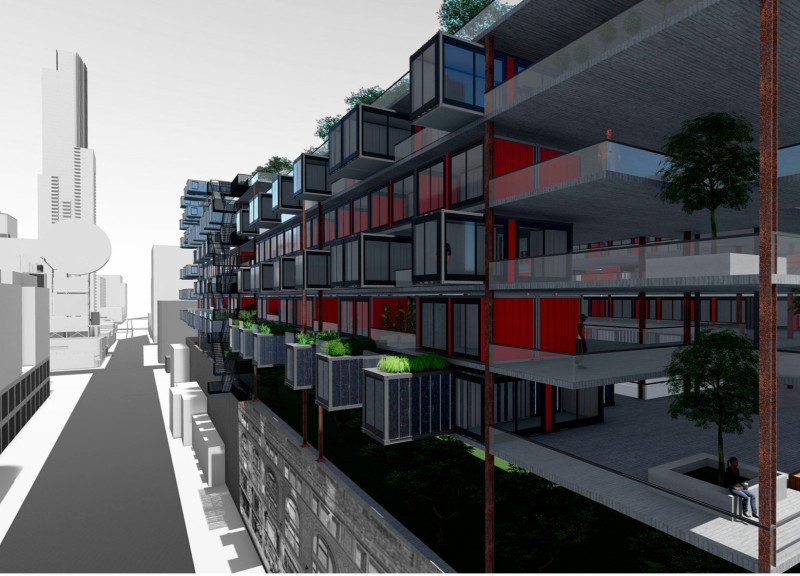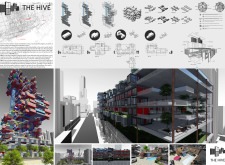5 key facts about this project
At its core, The Hive represents a thoughtful response to urban density and housing shortages. It seeks to redefine the idea of community living, bringing people together while respecting their need for privacy and personal space. The architectural design of the project is centered around modular units that can accommodate a diverse range of residents, from single professionals to families, thereby fostering inclusivity in urban living.
The design emphasizes a stacked, cube-like configuration, reminiscent of natural forms such as honeycombs, which not only serves aesthetic purposes but also enhances the building's functionality. This vertical arrangement allows for optimal light and air circulation, creating a healthy living environment. Each unit is crafted with flexibility in mind, providing adaptable layouts that can change based on the tenants' needs.
Key components of The Hive include an array of communal spaces that promote interaction among residents. These spaces, designed with consideration for social connections, are integrated within the building to enhance the community aspect. Features such as shared gardens, gathering zones, and open-air terraces enable residents to engage with one another, forming bonds that are essential in urban living.
The materiality of The Hive is well thought out, employing a harmonious mix of concrete, prefabricated steel panels, glass, and wooden elements. The robust nature of concrete ensures the building’s structural integrity, while the prefabricated steel panels allow for efficient construction and reduced onsite waste. Large glass windows and balconies invite natural light into the units, creating bright and welcoming interiors, while wooden elements add warmth and a sense of home. The thoughtful integration of greenery through potted plants and garden spaces adds a refreshing touch, inviting nature into the urban setting and enhancing the well-being of the residents.
Unique design elements are evident throughout The Hive, particularly in its emphasis on sustainability. The building features green roofs that not only contribute to insulation but also reduce the heat island effect common in urban areas. Properly designed natural ventilation systems aid in maintaining comfortable temperatures, thereby minimizing reliance on mechanical cooling systems.
The Hive also touches on the principles of scalability. The modular design allows for potential expansion or modifications as community needs evolve, providing an adaptable framework that can respond to changing demographics or population dynamics. This flexibility is crucial as cities face fluctuating housing demands over time.
Overall, The Hive is a notable architectural project that balances the need for efficient housing with the creation of vibrant community spaces. Its innovative design addresses the complexities of urban living in a straightforward manner, reflecting a commitment to functionality and sustainability. Readers interested in exploring this project should consider reviewing the architectural plans, architectural sections, and architectural designs to gain deeper insights into the unique ideas and approaches that inform The Hive.























